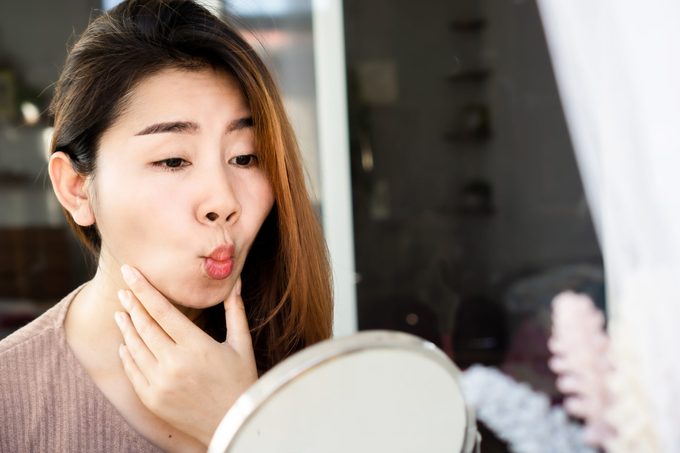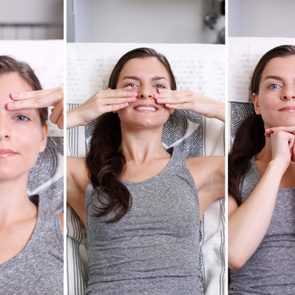Yes, “Face Yoga” Might Actually Make Your Skin Smoother, a Dermatologist and Plastic Surgeon Reveal
Updated: Jun. 23, 2022
Face yoga is seriously starting to trend as a supposed way to age more radiantly. But is it legit? Beauty experts say that in some cases, this practice could possibly fit into a holistic self-care regimen.
It was 2002 when the Food and Drug Administration approved Botox for cosmetic use. In the two decades since, this procedure that was once widely frowned upon has become a beloved, mainstream way to treat frown lines, along with your “elevens” between the brows, crow’s feet, and plenty more.
But thanks to the pandemic (which for a time made it impossible to get out and top up your Botox injection), combined with our culture’s growing love for the all-natural and organic, many consumers are looking for more authentic ways to achieve that same skin-smoothing effect.
And since millions of us count yoga as part of our regular self-care routine to facilitate good breathing, open joints, stretch muscles, and other therapeutic essentials … could there be any credence to the budding “face yoga” trend to keep your face fit? A dermatologist and plastic surgeon spoke with The Healthy to share their takes.
How else to begin getting healthier skin? Read Dermatologists Say This 1970s Anti-Aging Ingredient Is Still the Gold Standard for Gorgeous Skin.
What is face yoga?
Yawn as widely as you can. Knead your sinuses. Puff out your cheeks. Use your fingertips to tap your forehead. “Exercises” for your facial muscles, like these, are a few “face yoga” moves that some figures suggest can help your face appear firmer and more youthful.
Face yoga—a series of facial movements and massage techniques designed to work the muscles beneath the skin of the face—might sound pretty perfect. However, among some beauty enthusiasts, it’s a rather contested topic.
We all know: As we age, our facial skin changes. It might show wrinkles, sag, or sink a bit; all progressions that are simply part of nature. The beauty in aging is an increasingly celebrated phenomenon … but if you could practice a few facial exercises as part of your skincare routine to preserve your current appearance, would you actually see a difference?
Proponents of face yoga say it helps you achieve smoother changes in your face, just like doing glute exercises gives can give you a firmer, stronger bottom. Face yoga practitioners swear by this modality as the key to beautiful skin. There are even entire YouTube channels dedicated to the practice.
Yet others caution against face yoga, arguing that it presents the same problems as other repetitive facial movements, like how repeatedly sipping on a straw deepens wrinkles around the lips. Kind of makes sense, right?
So what do the experts say about face yoga?
The alteration in facial appearance as we age is the result of changes in both the skin itself and the underlying tissues, says Snehal Amin, MD, co-founder of MDCS Dermatology in New York and clinical assistant professor of dermatology at Weill-Cornell Medical College. “As you get older, you will see looser skin laxity and sun damage on the surface, along with the loss of fat and muscle in the underlying tissues,” Dr. Amin explains.
So … is he saying face yoga could work? “In theory, better muscle tone of the cheeks could mean less sagging,” he says.
But in practice, this isn’t quite clear. A 2018 study published in JAMA Dermatology attempted to give a scientific answer. Researchers gave 27 men and women a face yoga program—a 90-minute regimen of 32 exercises, to be done four times a week for two months. Likely thanks in part to the extreme time commitment, only 16 subjects finished the trial. Those who stuck with it all eight weeks reported a “small improvement in facial appearance.”
Did the other subjects drop out because they didn’t see an improvement? The study used a small sample and no control group, so critics might say it’s challenging to draw any real-world conclusions. (Plus, six hours of facial exercises each week for a “small improvement”? That time might be better spent dedicated to full-body exercise that science is sure keeps you young.)
What are the benefits of face yoga?

Face yoga may not be the new miracle cure for sagging and wrinkles—however, that doesn’t mean there aren’t any benefits to some facial exercises, says Alexis Parcells, MD, a plastic surgeon, founder of SUNNIE, an anti-aging clinic, and a clinical medical instructor at RWJ Barnabas Health.
Dr. Parcells suggests doing targeted exercises and massages for your face may show the following benefits:
- Improve symptoms of TMJ pain.
- Reduce chronic headaches.
- Increase lymphatic drainage in the face and neck (yes, please).
- Reduce tension and stress.
Dr. Parcells says there are more potential mental benefits to doing face yoga, as well. “This is a self-care technique and may improve confidence and help you feel more relaxed,” she explains. “By focusing on breathing while you do it, you can observe areas of tension and improve your current mood.” (To amp up the benefits, Dr. Parcells says face yoga is “best accompanied by positive affirmations about yourself and your body.” Here are a few body-positive affirmations to try.)
Does face yoga cause wrinkles?
So while face yoga may not really help, it probably can’t hurt to try it … right? Well, not so fast with those puffed-up cheeks. Could face yoga actually expedite the visible effects of aging?
Face yoga does have the potential to increase the development of wrinkles as you exaggerate and repeat some movements, says Dr. Amin. “Also something to consider is what look you prefer. In general, the more you use a muscle, the larger it gets,” says Dr. Amin. “Some people like a slimmer appearance to the jawline, [but] overusing the masseter muscle in the jaw can actually make it look bigger or bulkier.”
In fact, he suggests, this is the whole reason why Botox injections work to reduce wrinkles and make the face look younger. The botulinum toxin temporarily paralyzes the muscles in your face so they move less. (Some doctors actually use Botox to weaken the masseter muscle, making it smaller and giving the face a slimmer, smoother appearance.)
Face yoga could do the opposite.
(Meanwhile, here’s everything you need to know about Botox injections.)
Should you try face yoga?
The bottom line is that there just isn’t much real research into the techniques, and there isn’t a one-size-fits-all answer, says Dr. Parcells. The effect, good or bad, is likely fairly small—so if it all those facial taps and knuckle rubs make you feel happier, more confident, or clearer-headed, then they may be worth sticking with.
On the other hand, beauty doesn’t mean pain. If face yoga it feels like a chore or is painful in any way, this is one yoga session it’s fair to sit the bench for.
Sign up for The Healthy newsletter for beauty wisdom and lots more, and follow us on Facebook and Instagram. Keep reading:
- Skin-Tightening Treatments in 2022 That Can Take Years Off Your Face
- Craving Sugar? A Dietitian Says You May Need More of This Surprising Nutrient
- 12 Best Small Treadmills for Your Home or Apartment, According to Certified Fitness Experts
- Are You an Aspiring “Reducetarian”? These Are the 5 Smart Grocery Swaps You’ve Got to Try




















